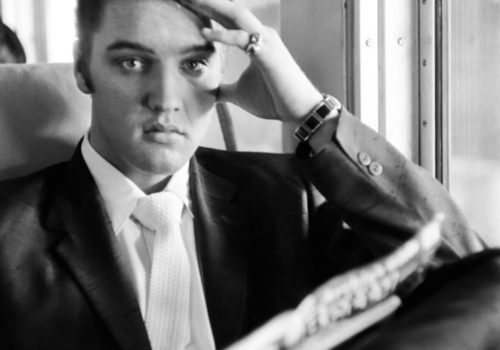Freelance photojournalist Alfred Wertheimer was hired by RCA Victor in 1956 to shoot promotional images of a recently signed 21-year-old recording artist, Elvis Presley. Wertheimer’s instincts to “tag along” with the artist after the assignment and the resulting images provide a look at Presley before he exploded onto the scene and became one of the most exciting and influential performers of his time. “Elvis at 21: Photographs by Alfred Wertheimer,” a new Smithsonian traveling exhibition, presents 56 of these striking images and opens at the National Portrait Gallery in Washington DC.
The 1956 photographs from the “Elvis at 21” exhibition show more than a musician on the rise. The images illustrate the calm before the storm—the simple and complacent American society before Elvis’ impact on youth and popular culture. The consumer market swelled with the arrival of the young performer, as radio, recordings and movies became the new definition of entertainment. “American musical culture was completely changed by the arrival of Elvis Presley,” said Martin Sullivan, director of the National Portrait Gallery. “Wertheimer’s photographs give us a glimpse into Presley’s world leading up to his catapult to stardom.”
Wertheimer had unparalleled access and documented Presley on the road, backstage, in concert, in the recording studio and at home in Memphis, Tenn. “Colonel” Tom Parker, Presley’s manager, restricted contact just a short time later. The photographs document a remarkable time when Presley could sit alone at a drugstore lunch counter. “Henri Cartier-Bresson was known for photographing the decisive moment, that moment when everything falls into place,” said Wertheimer. “But I was more interested in the moments just before or just after the decisive moment.” Wertheimer was up close to capture Presley’s flirtatious encounter with a young woman backstage in Richmond, Va. He was in the New York City recording studio on the historic day Presley recorded “Don’t Be Cruel” and “Hound Dog.” Both songs hit No. 1 on the charts, the first and only time a single record would achieve this distinction.
Wertheimer also joined Presley after the recording session as he traveled home to Memphis by train. One image shows Presley as just part of the crowd surrounding a lunch vendor on a train platform during a brief stop on the 27-hour trip. The anonymity he had during this stop was short-lived; the trip followed a busy few months when Presley appeared on the television shows Stage Show, The Milton Berle Show and The Steve Allen Show. The photographs of a concert in Russwood Park on his return to Memphis show a young man who needed a police escort to get through the crowd of fans between his car and the stadium. The large-format pigment editions in the exhibition were produced by master printer David Adamson. On opening his Washington, D.C., studio in 1979, Adamson became a pioneer in the craft of digital art printing. Adamson’s digital format, allowing for complete control over pixel, density, contrast and brightness levels, has remained the preferred printing method of many artists to date.
“Elvis at 21” co-curators, Amy Henderson, National Portrait Gallery historian and Warren Perry, the museum’s researcher, contributed introductory essays to the illustrated exhibition catalog, Elvis 1956, available in the museum bookstore. Published by Welcome Books the 128-page hardcover book is $29.95.
Developed collaboratively by the Smithsonian Institution Traveling Exhibition Service, the National Portrait Gallery and the Govinda Gallery, “Elvis at 21” will be on view at the Portrait Gallery through Jan. 23, 2011.
American Art and Portraiture at Eighth and F streets N.W., Washington, D.C. Smithsonian
















